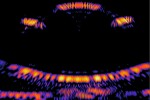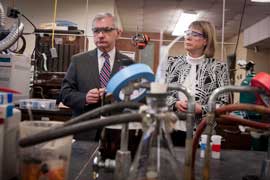News & Events
DHS COE News
RI Senator Jack Reed Visits ALERT at URI February 25, 2014

FROM URI NEWS, KINGSTON, RI – February, 25, 2014 — U.S. Sen. Jack Reed met Monday with University of Rhode Island professors from chemistry, engineering and cyber security to see firsthand some of the leading research they are conducting on explosives, explosives detection, and cyber security, and discuss efforts to strengthen URI’s role in physical and cyber security study.
During a campus tour yesterday with Gerald Sonnenfeld, URI vice president for research and economic development; Jimmie Oxley, URI professor of chemistry and director of the U.S. Department of Homeland Security Center of Excellence in Explosives, Detection, Mitigation, and Response at the University of Rhode Island; Otto Gregory, URI distinguished professor of engineering and co-director of the Sensors and Surface Technology Partnership; Lisa DiPippo, associate professor of computer science and the academic director of the Cyber Security Program at URI; Alan Davis of the Naval Undersea Warfare Center in Newport; and URI students, Reed observed demonstrations of some of the work URI is doing to improve security, detect explosives and neutralize their impact, and strengthen the nation’s cyber security capabilities.
[Photo Credit: URI Photos by Michael Salerno Photography.]
Northeastern University Selected to Lead Renewed Explosives Research Center of Excellence August 14, 2013

DHS S&T Press Office – Press Release, August 14, 2012
WASHINGTON – The U.S. Department of Homeland Security (DHS) Science and Technology (S&T) Directorate announced today the selection of Northeastern University’s Center for Awareness and Location of Explosives-Related Threats (ALERT) to lead a renewed DHS Center of Excellence (COE) for Explosives Research. S&T will provide ALERT with a $2.5 million grant for the first of five years.
“ALERT already has contributed substantially to the security of the United States through a top-notch explosives research and education program,” said Matthew Clark, Director of S&T’s Office of University Programs (OUP), which manages the COE system. “ALERT meets DHS’s high standards for scientific quality, and demonstrates readiness and ability to engage with DHS to solve real-world security problems.”
S&T selected the Northeastern-led team through an open call for proposals and a rigorous competitive process, marking the second time Northeastern and its partners have won this distinction. Under the leadership of Northeastern and the University of Rhode Island, the new ALERT COE will expand efforts initiated in 2008 by the existing Center. The renewed ALERT will collaborate with DHS S&T, DHS operational components, industrial partners, and other COEs to help the United States detect and defeat explosives threats. ALERT will also develop relevant educational curricula for both university students and mid-career professionals.
The DHS COEs were established by the Homeland Security Act of 2002 to be a “coordinated, university-based system to enhance the Nation’s homeland security.” S&T’s COEs are a well-integrated network of researchers focused on specific high-priority DHS challenges and work directly with DHS operational agencies to solve complex and difficult security problems.
For more information about OUP and the COEs, please visit www.dhs.gov/st-oup.
ALERT and Los Alamos National Laboratory (LANL) Receive $750,000 DARPA Award May 16, 2013
ALERT and Los Alamos National Laboratory have received a $750,000 DARPA award for their partnership in Nuclear Magnetic Quadrupole Resonance research. Their proposal was submitted and accepted for the Methods for Explosive Detection at Standoff (MEDS) program. This project will be led by Prof. Carey Rappaport, the Principal Investigator from Northeastern University, and partner lead, Michelle Espy, from LANL.
Follow-on Funding Awarded to Dr. Conrad Jones January 16, 2013

Dr. Conrad Jones, a faculty member at Southern University, was awarded $50,000 of follow-on funding through the DHS Summer Research Team Program for MSIs. Dr. Jones was originally chosen to participate in the program during the summer of 2012 to work on ALERT research with Profs. Louisa Hope-Weeks and Brandon Weeks at Texas Tech University.
At the end of the summer, faculty participants are encouraged to apply for up to $50,000 in follow-on funding to continue the research collaboration at their home academic institutions during the following academic year.
Congratulations Dr. Jones!!!
(Photo Source: https://www.orau.gov/dhseducation/)
ALERT welcomes United States Secretary of Homeland Security, Janet Napolitano November 19, 2012

Awareness and Localization of Explosives-Related Threats was pleased to host U.S. Secretary of Homeland Security, Janet Napolitano on Monday, November 12th following her keynote address at Northeastern University’s Veteran’s Day Ceremony.
To kick off the visit, ALERT’s Director, Professor Michael B. Silevitch, provided Secretary Napolitano with an overview of the ALERT Center of Excellence. Prof. Silevitch then introduced undergraduate and graduate students involved with ALERT research and gave a summary of the demonstrations in video analytics and advanced imaging technologies that were prepared for her briefing. Michael described Napolitano’s visit as a significant opportunity for ALERT and its homeland security research, saying,
“It was very important to get validation from Secretary Napolitano about the relevance of our research and its transition to the field in the areas of video tracking of threats and passenger screening. This acknowledgement inspires us.”
Professor Octavia Camps led the first demonstration featuring ALERT’s Engage to Excel (E2E) Video Analytic Surveillance Transition project, VAST. VAST is a program developed in partnership with Siemens and the Cleveland Transportation Security Administration. The live demonstration exhibited the video analytic counter-flow program developed by Dr. Camps and her team and its ability to automatically detect when a person is proceeding the wrong way in an identified traffic pattern (for example, trying to enter through an exit). The resulting detections enable quick identification of an incident and minimize the impact on TSA resources. This project is currently installed within the Cleveland Hopkins International Airport.
Following the video analytics demonstration, Professor Carey Rappaport showed Secretary Napolitano the capabilities of the ALERT Advanced Imaging Technologies (AIT) laboratory. This laboratory fuses together various scanning tools to create next-generation security scanning systems. Professor Rappaport, Assistant Professor Jose Martinez and graduate student Spiros Mantzavinos demonstrated the operation and data acquisition capabilities of ALERT’s advanced portal-based millimeter-wave imaging radar. During the demo, the system scanned a mannequin wrapped in a skin simulant with various representative objects attached for detection. These types of AIT systems can be used to detect illicit items that passengers may be attempting to carry on their person.
“As a DHS-supported researcher, I found Secretary Napolitano’s visit very satisfying,” Prof. Rappaport commented. “She was of course quite knowledgeable about the science and technology we are pursuing, but she seemed keenly interested in how we were improving the state of the art. She was completely supportive and she motivated the students with her passion to keeping Americans safe.”
Spiros Mantzavinos, currently a Northeastern University Doctoral Candidate in Electrical and Computer Engineering and Gordon Engineering Leadership Fellow, had the opportunity to meet Secretary Napolitano. Mantzavinos said, “It was an honor to host Secretary Napolitano for a visit to our ALERT whole-body imaging lab. Receiving attention and recognition from such a prominent figure in the national security arena assures the relevance of the advances we are making.”

